Last updated 3 February 2021
I wrote most of this story 18 months ago for an outdoors/adventure magazine that ended up changing their editorial focus and no longer required my story. During these quieter times with Coronavirus placing a ‘hold’ on the need for travel stories, I want to continue writing and sharing my travel experiences. So I dug out this story on a trip to Scotland I did back in May 2018 and re-wrote parts to include not only the hiking details, but the journey as well.
With the current international travel restrictions imposed around Covid-19, we can still dream, be inspired, and plan for when we can travel again.
I also want to publish my Skye story for another reason – April 12 marked the third year of my Dad’s passing. If nothing else, my father was my inspiration for going to Scotland and now he is for publishing the story on my blog.
It’s been two years since my Isle of Skye trip – but the memories are vivid as if I had stepped onto the island only a few months ago. Please read on and discover the magic of Skye.
Hiking on the Isle of Skye
The Isle of Skye on Scotland’s west coast offers a delectable assortment for the outdoor enthusiast. I recommend deviating from the well-known routes and uncovering a few of Skye’s gems in the more remote regions.
Spoiled for hiking choices in Scotland I chose Skye because I wanted to experience first-hand the spectacular scenery everyone talks about and shares on social media. And I’ve always loved the Skye Boat Song. (Read that story here.) Whenever I’d hear those evocative lyrics at the opening of the Outlander TV Series (I’ve confessed to being an Outlander fan) I knew I had to visit the inspiration for the ballad.
As one of Scotland’s top three tourist destinations along with Edinburgh and Loch Ness, Skye features regularly in articles as a must-see location. However, there is a downside to being so popular: over-tourism. During peak season, (June through August) an excessive number of tourists descend on the island, which is only 80 kilometres from north to south. Because I was keen to avoid Skye’s over-tourism (and those midges that appear around mid-May) I signed up for Wilderness Scotland first seven-day walking tour of the season, for the end of April (2018.) Out of a number of very competitive hiking companies, I chose Wilderness Scotland for their low group numbers (capped at eight) and their range of walking destinations.
Late April, I flew to London, where I finally met in person a writer colleague (we’d connected a year earlier ‘online’ through the Australian Writer’s entre) Amy and I had planned a trip to Iceland (after my Scotland adventure.) A few weeks before leaving Aus, she decided to also accompany me on the Skye hike.
After reacquainting myself with the capital of England, including doing this fabulous foodie tour around the East End and returning to my old stomping ground of Wimbledon (much reminiscing), I caught a train from London’s Euston station to Glasgow. I enjoyed a few fun days exploring Glasgow before Amy arrived late on Friday night for the start of our Wilderness Scotland tour the following day. After a very early wake-up call (the hotel’s smoke alarm had confused guests, most still in PJs, having to gather outside in the hotel car park at 5 am) we caught a train to Inverness to meet our hiking crew.
About Skye
Travel options to Skye are limited. Buses around the island are infrequent. A car is an optimal choice to reach the more remote parts of the island. Inverness is 180 kilometres from picturesque Portree, the island’s capital (three hours by car.) The easiest approach to Portree is along the A87 via the free Skye road-bridge, spanning the sea between the villages of Kyle of Lochalsh (the Mainland) and Kyleaskin [Skye.]
Or you could travel in the manner the lyrics from my favourite Scottish song suggest: ‘Over the sea to Skye.’ The Glenelg to Skye ferry is the world’s last working manually operated ferry turntable and the shortest method (a 10-minute journey) to cross to Skye from the Mainland. (Ferry service is summer only – Easter to October.)
There is no railway on Skye. The nearest train station on the mainland which connects to Skye is: from Glasgow to Mallaig followed by a ferry trip to Skye. Or via Inverness to Kyle, then by bus to Skye. Travelling by train from London to Inverness (via Glasgow) is both comfortable and affordable.
Jen’s tip: Book your train trip online a few months earlier to save on your fare. Purchasing a ticket on the day of travel is expensive (as I found out!)
The history of Skye Clans, Castles and Dinosaurs footprints
Like so many places in Scotland, Skye’s history is rich, colourful and at times, barbaric. Fossilized dinosaur footprints on the island’s northeast coast in Staffin on the beach at An Corran, indicate these ancient creatures crossed the sandy beach some 165 million years ago. In 2015 further fossilised dinosaur footprints were discovered near the shore of Duntulm Castle at the north of the Trotternish Peninsula. They date to the Jurassic Period, 170 million years ago. As for humans, the island has been occupied since the Mesolithic period, (12,000 and 7,000 years ago.) Small round towers called Brochs (archeologists date them to be 2000 years old) are found all over Skye.
Skye was ruled from the 12th Century by two dominating and feuding Scottish families – Clan MacLeod and Clan MacDonald. The oldest continuously inhabited castle in Scotland, Dunvegan Castle, the stronghold for Clan MacLeod since the 13th century, is found on Skye’s west coast.
Clan MacDonald owned numerous castles around Skye (and Scotland) including the 18th Century Armadale Castle in the south of the island.
The Highland Clearances that took place in the 18th and 19th Centuries were a bleak period in Scottish history. Wealthy English landlords evicted many Scottish villagers from lands they’d been crofting (a form of land tenure unique to the Highlands) to make way for what they considered more prosperous use of the land – the running of sheep. Crofters who relied on the land for sustenance were forcibly removed from their homes without warning. Some relocated to other townships, while others left Scotland re-settling in countries like America, Australia, and New Zealand. This forced upheaval caused a dramatic drop in Skye’s population, declining from 20,000 to 9,000 in the 21st Century. The Highlands and the Islands of Scotland became one of the most sparsely populated areas in Europe.
Skye’s last census in 2011 records a small increase to 10,008.
Inverness to Uig via Portree
Day one
At Inverness, we meet our tour guide Judith Work (Jude) a Glaswegian lass who I later discover, has hiked more of the world in her 30 years than I have in my 50 plus years. We pile our packs into the back of a large black van and climb inside. There’s ample room for our group of seven. Jude will drive us to Skye’s capital, the picturesque town of Portree. Enroute we make a quick stop at the highly photographed Eilean Donan Castle near Dornie. This grand old 13th Century castle is perched on an island where three lochs meet. With the perfect weather conditions, we grab a few insta-worthy photos.

Eilean Donan Castle Kyle of Lochalsh
Crossing the Skye bridge into Portree, we head to Deli Gasta for lunch (Jen cannot resist purchasing a few locally made candles: Food + gifts = a great combination.) In the town of Portree, Jude finds a place to park the van and we begin our first hike of the tour, the Scorrybreac Circuit around the loch. The clear day provides spectacular vistas towards the distant snow-capped peaks of Ben Tianavaig and the Dun Caan (443m) on neighbouring Raasay Island.
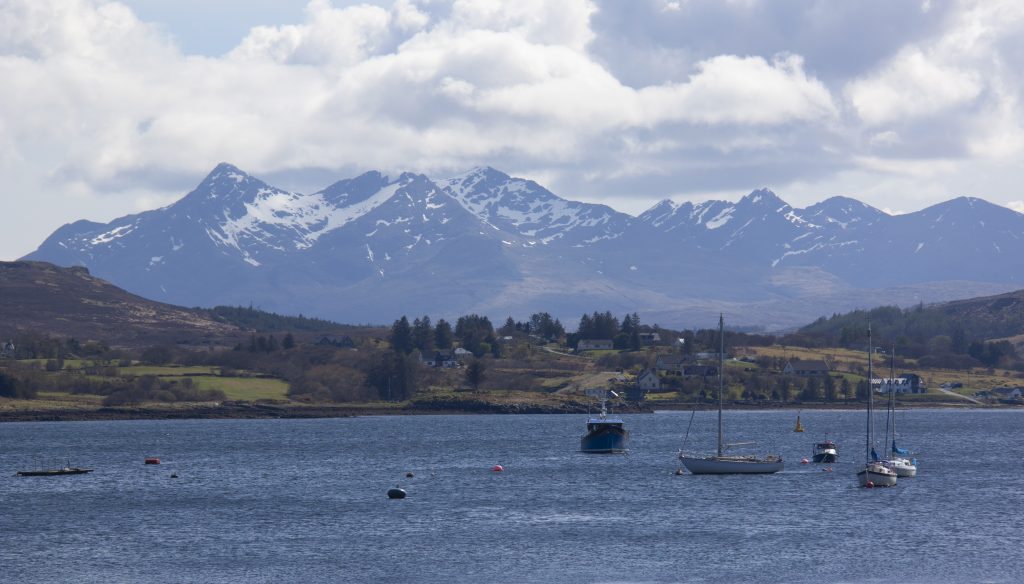
Views across Loch Portree
The well-defined path commences on the town’s perimeter, hugging the coastline for half a kilometre before zigzagging inland and upwards to the top of a cliff with magnificent views to the water below.
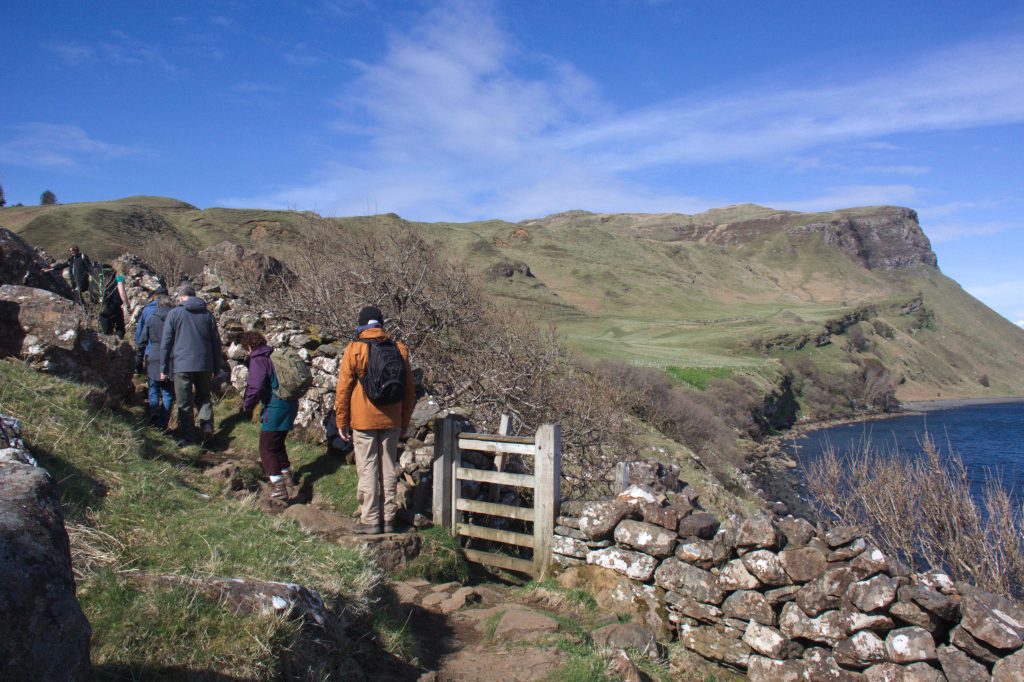
Scorrybreac Circuit heading inland from Portree
The final section of the walk is through woodland, presenting an opportunity to chat with our fellow hikers who hail from London and America.

The old shed across the road from the Uig Hotel – Isle of Skye
From Portree, we travel north to the town of Uig on the Trotternish Peninsula. The grand old Uig Hotel originally built in 1831 as an Inn, is home for the next three nights. I know I keep banging on about the views, but take a look at the vista overlooking Uig Bay (ohhh to be there right now.) There isn’t a table with a bad view inside the hotel’s restaurant, where we’d enjoy breakfast each morning. The same with the small tables on our room’s front landing – perfect for late afternoon R & R (and a Talisker whisky with our hiking friends.) The Uig Hotel is centrally located for exploring the Quiraing, The Old Man of Storr and Kilt Rock. It is also the departure and arrival point for the ferry to the Outer Hebrides.
Summary of hike Scorrybreac Circuit
Walk details: 4km, approx. 2 hrs. Well defined paths throughout. The first half of the walk is over rough stones and a steep ascent.
Waternish Point
Day two
There’s no sign of Scotland’s inclement weather. For the second day the skies are clear and the temperature a balmy 15 degrees. Jude drives our group (minus Amy who stayed back at the Hotel to rest and get over a nasty cough) to the Waternish, a remote corner of the island, on the northern tip of the Peninsula. Our hike begins north of Dunvegan, at the ruins of the roofless medieval Trumpan church overlooking Ardmore Bay.
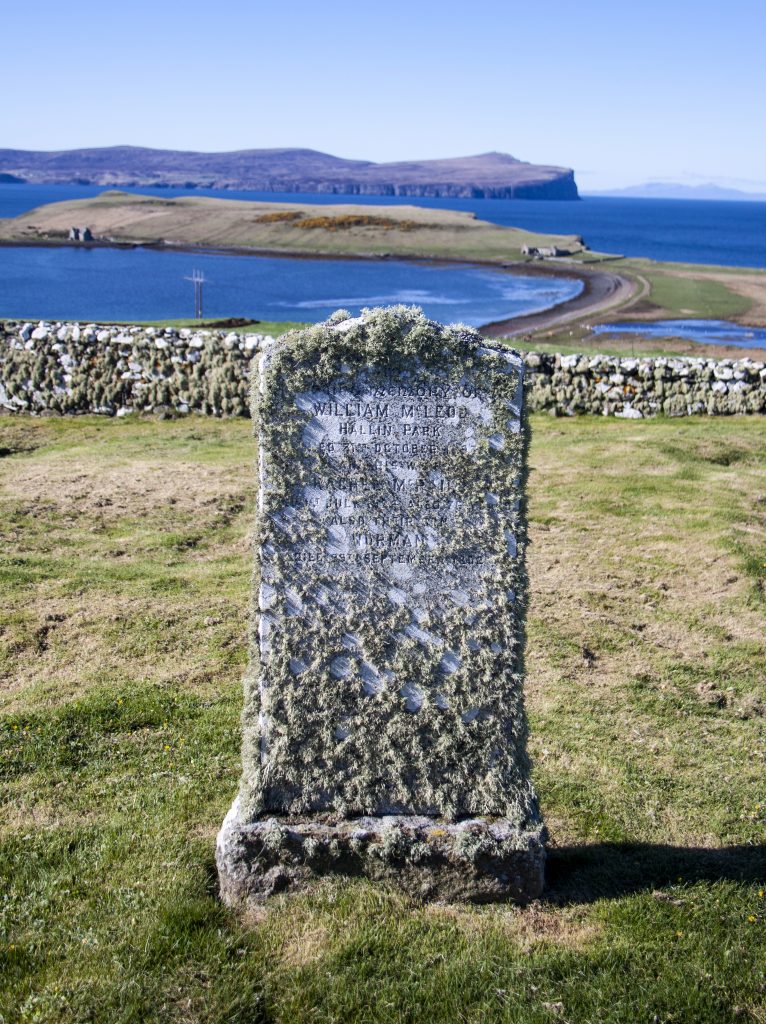
Headstone of William McLeod at the ruins of the Trumpan Church Waternish Peninsula
Jude shares a grisly story about Skye’s warring clans, the MacLeods and MacDonalds. In 1577 an ongoing feud escalated after the MacLeods massacred 395 MacDonald clansmen inside a cave on the island of Eigg, part of the Inner Hebrides to the south of Skye. A year later, the MacDonalds sought revenge, sailing into Ardmore Bay early one Sunday morning. In stealth mode, the MacDonalds snuck up to the Trumpan church where the MacLeods were inside worshipping. The MacDonalds boarded the doors to the church trapping the worshipping MacLeods inside. They set fire to the roof of the church. Those inside all died, except for one young girl, who managed to escape through a skinny side window. She ran to the remaining MacLeod clan members and raised the alarm. The feud continued between the clans, resulting in further bloodshed and more dark tales of death.

Trumpan Church ruins Waternish Peninsula
Today, wandering around the serene church grounds, watching clumps of yellow daffodils sway in the gentle breeze, it’s hard to envisage the carnage that took place here a few centuries earlier. Some of Scotland’s history was fraught with violence. Thankfully all part of history now.
With somber thoughts of battles past, we left the ruined church, following a well-trodden path through farming paddocks, the Scots fondly call moors. Grazing cattle lift their heads for a nonchalant glance towards the wandering humans, returning quickly to their munching. Our group ambles over cattle grids and across a few small streams. We pause near a man-made pile of rocks, stacked about 1.8 metres in height.
“This is a cairn, often used by hikers to mark trails,” Jude explains.
This one is a memorial cairn, dedicated to Roderick MacLeod who died around 1530 in a battle against the MacDonalds on the moor we’re walking upon.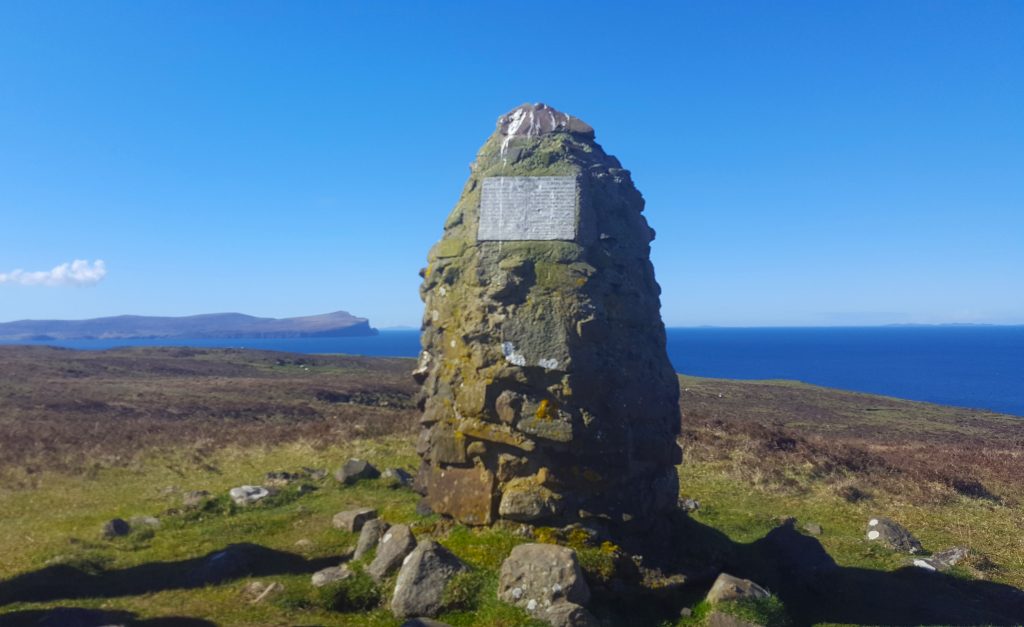
Half an hour later, we come across our first Broch. The weathered scattered grey stones didn’t look like they had a purpose now, but around 2,000 years ago Jude reassures us this would have functioned as a round tower and functioned as a fortified house.
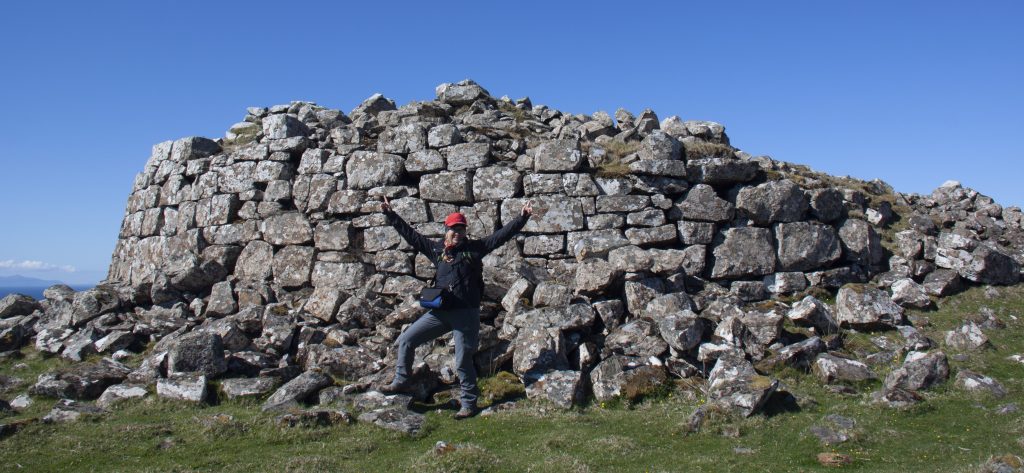
Jen finds her first Broch on the Isle of Skye
On the return journey, we’re rewarded with spectacular clear ocean views towards the Islands of Lewis and Harris – the largest of the Scottish islands.
During the drive back Jude suggests we take a look at a local industry Skyeskyns The last remaining commercial woolskin tannery in Scotland was created in 1983, by Clive and Lydia Hartwell when Clive fell in love with the beautiful coastal village of Waternish. Today Skyeskyns is a popular tourist attraction, managed by the second generation of the Hartwell family. We received an entertaining tour of the wool skins process with Dave Owen, who funnily enough, sounds very un Scots-like. (He hails from Shropshire.)
Our group (especially the women) loved the Skyeskins handmade products in the upstairs gift shop. Soft to the touch, and silky smooth, if I lived in a colder climate I would have made a purchase! Skyeskins will ship to your home for a small fee (a few in our group took up this option – saves lugging your rug or boots around.)
Twilight makes for long days and even though the sun remains high in the sky, it’s almost dinner time and with all the hiking exertion, we’re all hungry. Jude recommends Edinbane Inn. It’s Sunday afternoon and a trio of local musicians entertain the patrons with some live folk music.
To my pleasant surprise, the bar stocks Bundaberg rum and Bundaberg ginger beer. In the land of whisky, it’s nice to (occasionally) indulge in a taste from my home state (very unexpected given the remote location!) The hearty meals filled our tummies – a very pleasant evening. (I wish this was my local.)

Dark and Stormy in the middle of Isle of Skye (Edinblane Inn) who knew?
Summary of hike: Waternish Point
Most of the approach walk is on a good track, rocky and boggy in places.
Walk details: 13km approx. 5 hrs
Trotternish Peninsula and the Quiraing
Day three
To Skye’s north on the Trotternish Peninsula is an area called the Quiraing, harbouring some of the island’s most beautiful and unusual scenery. Spread out over 8.5 square kilometres, the two-kilometre wide ridge snakes all the way down to the sea (the Outer Hebrides.) The Quiraing dates back to the Jurassic period (175 million years ago.) A series of spires, buttresses and jagged rock formations were created when lava oozed from the ground in vertical peaks. The dramatic backdrop wouldn’t be out of place in a Lord of the Rings movie.
Near the junction of the roads between Staffin and Uig, Jude parks the van in a large car park. At 249 metres above sea level, the car park provides spectacular views to the Sound of Raasay, Torridon and Wester Ross. If you’re limited for time, you could take in this view and leave. But you’d be missing so much. I recommend lingering for longer. There are many, many rewards inside the Quiraing.

View from the car park at the Quiraing Isle of Skye
For those preferring a short walk, you can follow the first section of the path. But for a real taste of the Quiraing, venture beyond the fractured rocky towers named the Prison and the Needle and hike the circuit.

The Needle at the Quiraing
Follow the path to Flodigarry, cross a small gully before climbing approximately 500 metres to reach a gap between the main cliffs of the Quiraing. The 36-metre tall Needle with its craggy limestone top reaching skywards, stands like a sentinel clad in camouflage-coloured combat gear, guarding the rock formations below. The walk continues to a fork in the path, where we head left into a hidden glen passing small lochans (water tables.) I was half-expecting the Lord of the Rings wizard, Gandalf, would appear from one of the towering basalt formations.
The path climbs to a stile on the ridge-line called Fir Bhreugach. Here, you can walk 50 metres further to a rocky ridge called Sron Vourlinn that extends outwards towards the water. Amy and I walk to the end of the ridge, standing on what looks like an outstretched dragon’s head. Our efforts are rewarded with spectacular views to the east.
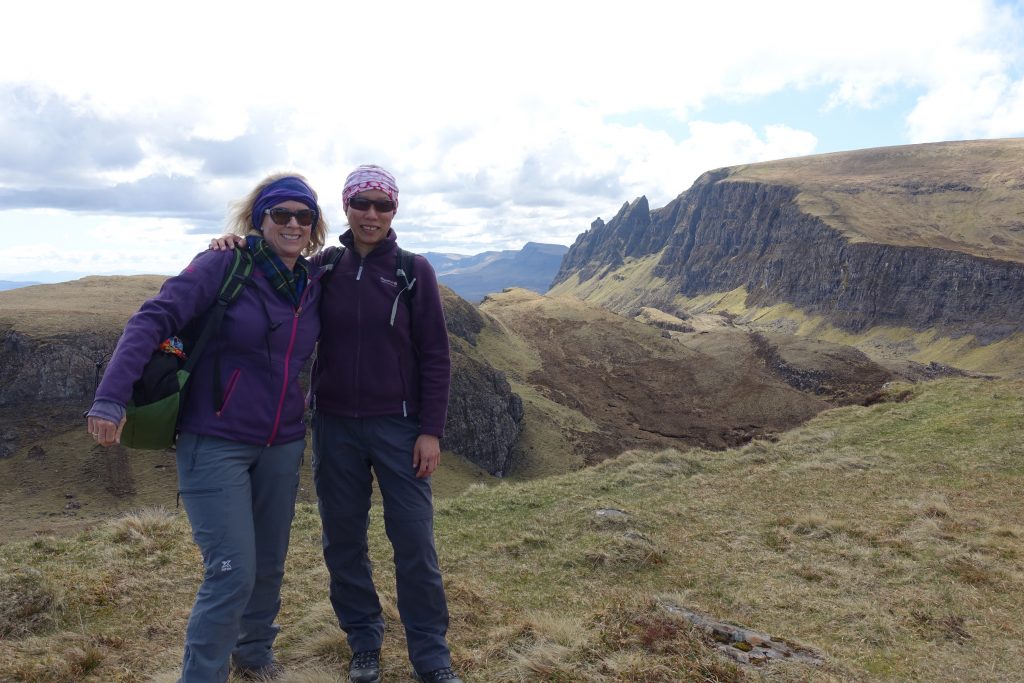
Amy and Jen on a ridge near Sron Vourlinn in the Quiraing
A slow steady ascent along the edge of an escarpment brings us to the highest point. The exertion is worthwhile for we all take a moment to stand and stare at the stunning views across Staffin Bay to the Torridon Mountains. (We were lucky to have a clear day.)
The descent to the car park involves weaving back and forth along a rough and partly eroded path. Despite using hiking poles for support, the steep climb down is a good test for my knee and its reconstructive surgery 14 months earlier. With envy, I watch other walkers (including Amy) bound down like mountain goats.
Summary of hike: Quiraing Circuit Walk
Initially a good path, rough and rocky in places. Return over hill is exposed and final descent is very boggy, steep and eroded in places.
Walk details: 8km approx. 4 hrs

Our crew: Jen, Jocelyn, Tom, Margaret, Amy, Sue and Dave (behind) photo credit: Judith Work
If you’ve made it to here, well done! This is where I’ll leave this blog story – on the Quiraing on day three. You wouldn’t think much could top that day’s hiking and scenery – but Skye has much, much more.
Blog posts shouldn’t be too long, I have to try and curtail my passion for Skye. But if you’re interested, the second installment of days four to seven will follow.
*Note the writer paid for her Wilderness Scotland adventure in full. This was not a sponsored or media trip. All opinions expressed are my own.
Love! I am from Scotland and spent summer holidays as a child sailing around the Hebrides, including several trips to Skye. As an adult I went filming there a few times when working for the BBC, and camping too. Happy days! Your photos are terrific and really do it justice. I almost went on a wild swimming day trip in 2018 but didn’t in the end, so hopefully next time in Scotland I will manage that and widely walking too.
Thank you Seana for commenting. Wow, must have been a wonderful childhood. I haven’t been to the Hebrides but would like to one day! I’m up for a wild swimming day and more hiking / walking. Bring it on when we’re allowed to travel again. Jennifer x